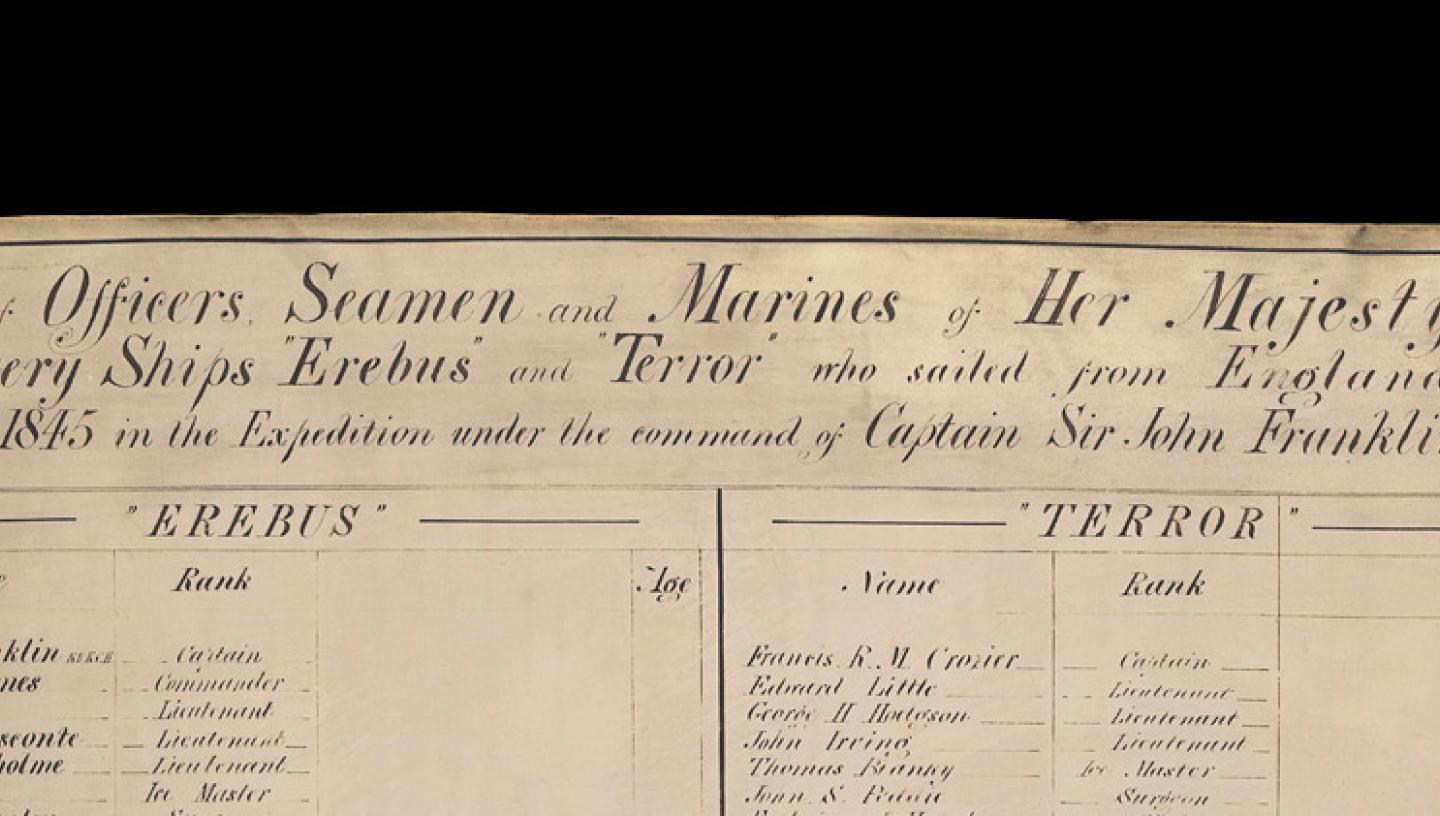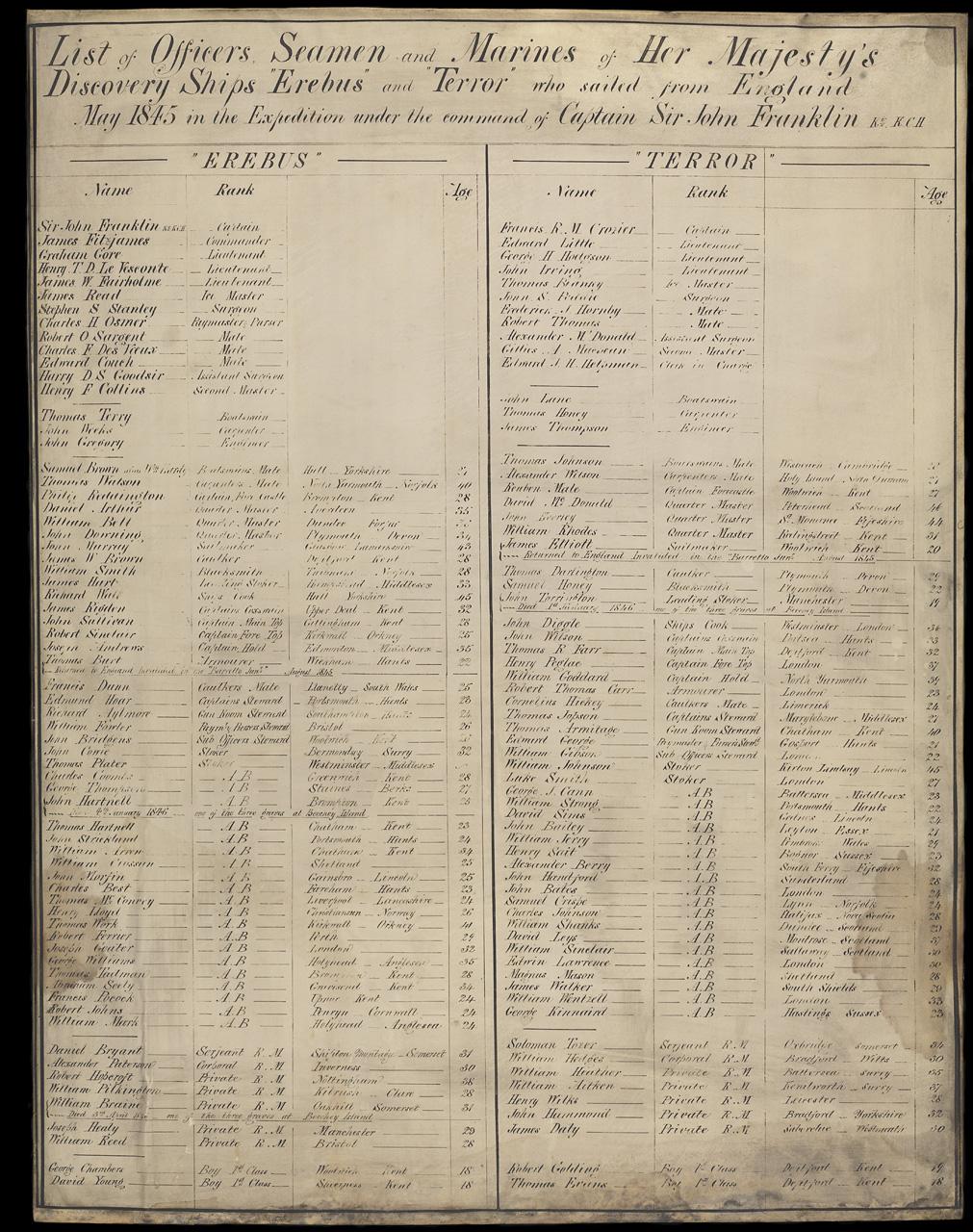
Essential Information
| Location |
National Maritime Museum
|
|---|---|
20 Dec 2016
Librarian Penny Allen looks at the human tragedy of Franklin's final and fatal expedition, and what we can know of the heroic men who were lost.
by Penny Allen, Librarian
The discovery in September 2016 of HMS Terror, one of the ships of Franklin’s 1845 Arctic Expedition, has once again piqued interest in the fate of both of these Royal Naval vessels. HMS Erebus was found in September of 2014, in the Canadian Arctic. The excitement over the discoveries of the ships overshadows the sad reality that 129 men perished. The men’s families grieved without knowledge of their final resting place. Indeed, an exact location of most of the men will possibly never be known.
Memorial plaque to the crews of Erebus and Terror
The ‘item’ this article centres around is a memorial plaque bearing the names of both crews of the Erebus and Terror.
The plaque was originally located in the Royal United Services Institution (RUSI) offices and was donated to the museum.
This plaque can be ordered to view in the Library reading room.
'Failure in no way diminishes their heroism'
Ralph Lloyd-Jones, one time employed with the Fulham Library, London, has done a remarkable amount of research into the backgrounds of many of the men of HMS Erebus and Terror, reaching back into their ‘sea’ lives using Description Books and Muster Books (found at the National Archives). In addition, he used genealogical resources such as census records and parish registers.
According to his articles, published in the Polar Record journal, found in the library collection, most of the men who were chosen by the Admiralty had varying amounts of experience in previous Arctic voyages. The ships embarked from Woolwich, where they were fitted out for the Arctic voyage. Lloyd-Jones’s last comment in the article in regards to the failed search for the Northwest Passage is particularly poignant: ‘Failure in no way diminishes their heroism’.
The men found in the Arctic
The following information about the remains of the men who were found in the Arctic has been gleaned from the articles by Lloyd-Jones, the list of crew from MSS/84/140 and various print resources found in the library catalogue as well as concentrated internet research. Much more family information about other members of the crew can be found in LLoyd-Jones's articles.
- ARMITAGE, Thomas (bp. 1807, Chatham Kent) HMS 'Terror Gun Room Steward. (Beatty, Frozen in Time, p.3) […] ‘shortly after midnight on 25 May 1859, a human skeleton in the uniform of a steward from the lost expedition was found on a gravel ridge near the mouth of the Peffer River on the island’s southern shore’ - discovered by McClintock’s party. Originally thought to be Harry Peglar, but later believed to be Thomas Armitage.
- BRAINE, William. (b. 1826 Somerset d. 3 April 1846 Buried: Beechy Island) HMS Erebus Private 3rd Class. Enlisted in the Royal Marines 24 Dec.1833. His body was exhumed in 1986 by Canadian anthropologist Owen Beatty and his team to try to ascertain the cause of death and conduct a more thorough examination of the remains. Reburied in the same site.
- GOODSIR, Harry. (b. Scotland, c.1820 ) HMS Erebus, Assistant Surgeon. Body discovered by Inuit who later led an American adventurer to the site. [no date] The remains were returned to England. The skull was used to reconstruct facial features and was then compared to a daguerreotype photo taken of Goodsir in Scotland. There is hope that family will come forward to provide DNA evidence to confirm this conclusion.
- HARTNELL, John. (b. c.1820 Brompton, Kent d. 4 Jan.1846. Buried: Beechy Island) HMS Erebus Private, Able Seaman. Hartnell was also exhumed by Owen Beatty – see BRAINE entry. Reburied in the same site.
- PEGLAR, Harry. (b. 1808 London; 37 in 1845) HMS Terror, Captain of the Foretop. A number of Peglar’s personal items were found with an unknown seaman’s remains by the McClintock search party. It is thought that the seaman was Peglar’s friend, Thomas ARMITAGE. Peglar served with ARMITAGE on the ‘Gannett’ in 1834.
- REID, James (Possibly from Aberdeen.) HMS Erebus, Ice Master – identified by reconstructing facial features from a skull brought back to the UK in 1993.
- TORRINGTON, John. (b. 1827 Manchester d. 1 Jan.1846. Buried: Beechy Island); HMS Terror, Chief Stoker.
- UNKNOWN – Unidentified remains. 1. In 1859 at Cape Crozier, Lieutenant Hobson (of the McClintock expedition) found a Franklin expedition boat containing two human skeletons. (Beatty : photo) 2. […] part of a bleached human skull was discovered on a low spit of land that juts into the icy waters of Simpson Strait (Beatty, Frozen in Time, p.3)
There is much speculation about the location of Franklin’s final resting place. Kamookak, an Inuit, states that according to oral accounts, Franklin may be buried somewhere on King William Island. Another account points to the possibility that his remains may still be inside the HMS Erebus.
Find out more
Many and well known publications are available to research at the Caird Library and a worthwhile mention is HMS Erebus and the Franklin Expedition ISBN: 9781844865086 written by Gillian Hutchinson (retired NMM Curator, History of Cartography) due to be released in 2017.
See also this article written by our curators:
